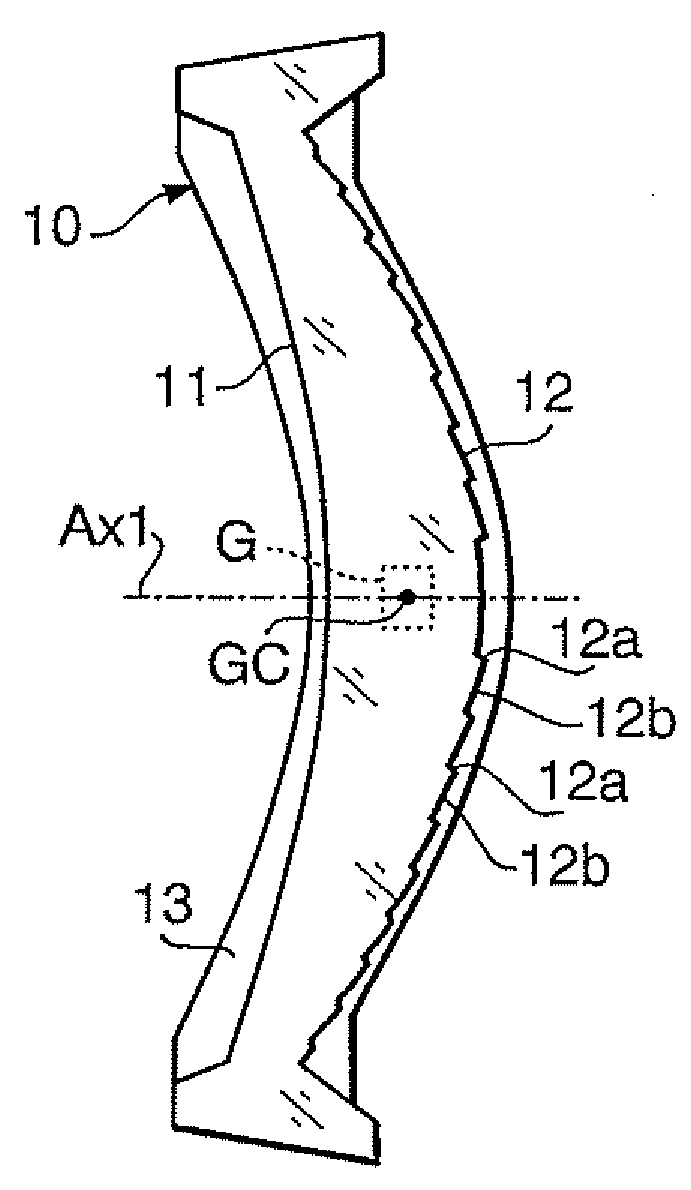Diffractive lens and scanning lens formed with diffractive lens
a diffractive lens and scanning lens technology, applied in the field of scanning lenses, can solve the problems of deterioration of printed images, affecting the accuracy of scanning images, so as to achieve the effect of high value and retained diffractive efficiency
- Summary
- Abstract
- Description
- Claims
- Application Information
AI Technical Summary
Benefits of technology
Problems solved by technology
Method used
Image
Examples
first embodiment
[0027] First Embodiment
[0028]FIG. 1A shows a cross sectional side view of a scanning lens 10 according to a first embodiment of the invention, and FIG. 1B is a front view of the scanning lens 10 shown in FIG. 1A. It should be noted that FIG. 1A is a view take along line P-P of FIG. 1B. The scanning lens 10 is arranged between a polygonal mirror and a photoconductive drum of a scanning optical system. Specifically, the scanning lens 10 is arranged such that a first surface 11, which is on the left-hand side in FIG. 1A, is on the polygonal mirror side, and a second surface 12, which is on the right-hand side in FIG. 1A, is on the photoconductive drum side. As shown in FIG. 1B around the lens surfaces allowing the light to transmit, a rib 13 used for fixing the scanning lens 10 onto a device is formed. In FIGS. 1A and 1B, G denotes a gate and GC represents the center of the gate.
[0029] Generally, a scanning lens to be used in a laser printer or the like, light scans in one direction (...
second embodiment
[0045] Second Embodiment
[0046]FIG. 9 shows a cross-sectional side view of a scanning lens 100 according to a second embodiment. The scanning lens 100 is particularly effective when a gate is formed on the rib 13 at a position on the optical axis projected on a plane parallel with the main scanning plane.
[0047] The scanning lens 100 is configured such that the first surface 101 is a concave surface, a macroscopic shape of the second surface 102 is a convex surface (i.e., the scanning lens 100 is a positive meniscus lens macroscopically), and a diffractive lens structure is formed on the second surface 102. The diffractive lens structure includes a plurality of rotationally symmetrical annular zones which are concentric about the optical axis Ax1 of the scanning lens 100. The diffractive lens structure includes diffraction operating surfaces 102b that diffract light passing therethrough and stepped surfaces 102a connecting the adjoining diffraction operating surfaces 102b. Around the...
PUM
 Login to View More
Login to View More Abstract
Description
Claims
Application Information
 Login to View More
Login to View More - R&D
- Intellectual Property
- Life Sciences
- Materials
- Tech Scout
- Unparalleled Data Quality
- Higher Quality Content
- 60% Fewer Hallucinations
Browse by: Latest US Patents, China's latest patents, Technical Efficacy Thesaurus, Application Domain, Technology Topic, Popular Technical Reports.
© 2025 PatSnap. All rights reserved.Legal|Privacy policy|Modern Slavery Act Transparency Statement|Sitemap|About US| Contact US: help@patsnap.com



